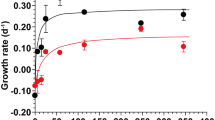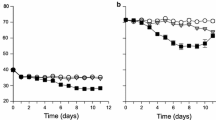Abstract
Chrysolepidomonas dendrolepidota was described recently and little is known of its distribution, physiology or ecology. Although many photosynthetic chrysophytes have been identified as mixotrophic, combining photosynthesis and phagotrophy, this study provides the first evidence of mixotrophic nutrition in C. dendrolepidota. In a 2 × 2 factorial experiment with relatively high and low levels of light and nutrients, the ingestion rate was highest in the high-light, low-nutrient treatment. Growth rates and abundance increased in high- versus low-light conditions. In additional experiments with nitrogen and phosphorus modified separately, ingestion rate was different from the control only in the treatment with both macronutrients reduced. Supplementing low-nutrient treatments with additional bacteria led to an increase in algal abundance relative to controls without added bacteria. These results indicate that acquisition of major nutrients is a likely driver of mixotrophic nutrition in C. dendrolepidota. Although the distribution of C. dendrolepidota is unknown, mixotrophic chrysophytes can seasonally dominate planktonic algal abundance in some aquatic systems, and nutrient limitation is known to increase bacterivory in some of those species. Identifying and understanding how different mixotrophic species respond to changing environmental cues is crucial to understanding their roles in aquatic food webs.





Similar content being viewed by others
References
Andersen, R. A., J. A. Berges, P. J. Harrison & M. M. Watanabe, 1997. Recipes for freshwater and seawater media. In Andersen, R. A. (ed.), Algal Culturing Techniques. Elsevier Academic Press, Burlington: 429–538.
Anderson, R., S. Charvet & P. J. Hansen, 2018. Mixotrophy in chlorophytes and haptophytes—effect of irradiance, macronutrient, micronutrient and vitamin limitation. Frontiers in Microbiology 9: 1704.
Bird, D. F. & T. J. Kalff, 1986. Bacterial grazing by planktonic algae. Science 231: 493–495.
Bird, D. F. & T. J. Kalff, 1987. Algal phagotrophy: regulating factors and importance relative to photosynthesis in Dinobryon (Chrysophyceae). Limnology & Oceanography 32: 277–284.
Boopathi, T., D. G. Faria, M.-D. Lee, J. Lee, M. Chang & J.-S. Ki, 2015. A molecular survey of freshwater microeukaryotes in an Arctic reservoir (Svalbard, 79 N) in summer by using next-generation sequencing. Polar Biology 38: 179–187.
Boraas, M. E., D. B. Seale & D. Holen, 1992. Predatory behavior of Ochromonas analyzed with video microscopy. Archiv fur Hydrobiologie 123: 459–468.
Caron, D. A., R. W. Sanders, E. L. Lim, C. Marrasé, L. A. Amaral, S. Whitney, R. B. Aoki & K. G. Porter, 1993. Light-dependent phagotrophy in the freshwater mixotrophic chrysophyte Dinobryon cylindricum. Microbial Ecology 25: 93–111.
Charvet, S., W. F. Vincent & C. Lovejoy, 2014. Effects of light and prey availability on Arctic freshwater protist communities examined by high-throughput DNA and RNA sequencing. FEMS Microbiology Ecology 88: 550–564.
Esteban, G. F., B. J. Finlay & K. J. Clarke, 2012. Priest Pot in the English Lake District: a showcase of microbial diversity. Freshwater Biology 57: 321–330.
Foster, B. L. L. & T. H. Chrzanowski, 2012. The mixotrophic protist Ochromonas danica is an indiscriminant predator whose fitness is influenced by prey type. Aquatic Microbial Ecology 68: 1–11.
Granéli, E., P. Carlsson & C. Legrand, 1999. The role of C, N and P in dissolved and particulate organic matter as a nutrient source for phytoplankton growth, including toxic species. Aquatic Ecology 33: 17–27.
Hobbie, J. E., R. J. Daley & S. Jasper, 1977. Use of nucleopore filters for counting bacteria by fluorescence microscopy. Applied and Environmental Microbiology 33: 1225–1228.
Holen, D. A., 2010. Mixotrophy in two species of Ochromonas (Chrysophyceae). Nova Hedwigia, Beiheft 136: 153–165.
Holen, D. A., 2014. Chrysophyte stomatocyst production in laboratory culture and descriptions of seven cyst morphophytes. Phycologia 53: 426–432.
Jones, R. I., 1994. Characteristics of particle uptake by the phagotrophic phytoflagellate Dinobryon divergens. Marine Microbial Food Webs 8: 97–110.
Jeong, H. J., Yoo, Y. D., Kang, N. S., Lim, A. S., Seong, K. A., Lee, S. Y., et al. 2012. Heterotrophic feeding as a newly identified survival strategy of the dinoflagellate Symbiodinium. Proceedings of the National Academy of Science of the United States of America 109: 12604–12609.
Johnson, M. D., 2015. Inducible mixotrophy in the dinoflagellate Prorocentrum minimum. Journal of Eukaryotic Microbiology 62: 431–443.
Kamjunke, N., T. Henrichs & U. Gaedke, 2007. Phosphorus gain by bacterivory promotes the mixotrophic flagellate Dinobryon spp. during re-oligotrophication. Journal of Plankton Research 29: 39–46.
Kristiansen, J. & H. R. Preisig, 2011. Phylum Chrysophyta (Golden Algae). In John, D. M., B. A. Whitton & A. J. Brook (eds), The Freshwater Algal Flora of the British Isles., An identification guide to freshwater and terrestrial algae Cambridge University Press, Cambridge: 281–317.
LeRoi, J. & G. Hallegraeff, 2006. Scale-bearing nanoflagellates from southern Tasmanian coastal waters, Australia. II. Species of Chrysophyceae (Chrysophyta), Prymnesiophyceae (Haptophyta, excluding Chrysochromulina) and Prasinophyceae (Chlorophyta). Botanica Marina 49: 216–235.
Lie, A. A. Y., Z. Liu, R. Terado, A. O. Tatters, K. B. Heidelberg & D. A. Caron, 2018. A tale of two mixotrophic chrysophytes: insights into the metabolisms of two Ochromonas species (Chrysophyceae) through a comparison of gene expression. PLoS ONE 13: e0192439.
Mitra, A., Flynn, K. J, Tillmann, U., Raven, J. A., Caron, D., Stoecker, D. K., et al. 2016. Defining planktonic protist functional groups on mechanisms for energy and nutrient acquisition: incorporation of diverse mixotrophic strategies. Protist 167: 106–120.
Nygaard, K. & A. Tobiesen, 1993. Bacterivory in algae: a survival strategy during nutrient limitation. Limnology & Oceanography 38: 273–279.
Pålsson, C. & C. Daniel, 2004. Effects of prey abundance and light intensity on nutrition of a mixotrophic flagellate and its competitive relationship with an obligate heterotroph. Aquatic Microbial Ecology 36: 247–256.
Peters, M. C. & R. A. Andresen, 1993a. The fine structure and scale formation of Chrysolepidomonas dendrolepidota gen. et sp. nov. (Chrysolepidomonadaceae fam. nov., Chrysophyceae). Journal of Phycology 29: 469–475.
Peters, M. C. & R. A. Andresen, 1993b. The flagellar apparatus of Chrysolepidomonas dendrolepidota (Chrysophyceae), a single-celled monad covered with organic scales. Journal of Phycology 29: 476–485.
Pienaar, R. N., 1976. The microanatomy of Sphaleromantis marina sp. nov. (Chrysophyceae). British Phycological Journal 11: 83–92.
Princiotta, S. D., B. Smith & R. W. Sanders, 2016. Temperature-dependent phagotrophy and phototrophy in a mixotrophic chrysophyte. Journal of Phycology 52: 432–444.
Ptacnik, R., U. Sommer, T. Hansen & V. Martens, 2004. Effects of microzooplankton and mixotrophy in an experimental planktonic food web. Limnology & Oceanography 49: 1435–1445.
Raven, J. A., L. A. Ball, J. Beardall, M. Giordano & S. C. Maberly, 2005. Algae lacking carbon-concentrating mechanisms. Canadian Journal of Botany 83: 879–890.
Rothhaupt, K. O., 1996. Laboratory experiments with a mixotrophic chrysophyte and obligately phagotrophic and phototrophic competitors. Ecology 77: 716–724.
Sanders, R. W. & K. G. Porter, 1988. Phagotrophic phytoflagellates. In Marshall, K. C. (ed.), Advances in Microbial Ecology. Plenum, New York: 167–192.
Sanders, R. W., K. G. Porter, S. J. Bennett & A. E. DeBiase, 1989. Seasonal patterns of bacterivory by flagellates, ciliates, rotifers, and cladocerans in a freshwater planktonic community. Limnology & Oceanography 34: 673–687.
Sanders, R., D. Caron, J. Davidson, M. Dennett & D. Moran, 2001. Nutrient acquisition and population growth of a mixotrophic alga in axenic and bacterized cultures. Microbial Ecology 42: 513–523.
Sherr, E. B. & B. F. Sherr, 1993. Protistan grazing rates via uptake of fluorescently labeled prey. In Kemp, P. F., B. F. Sherr, E. B. Sherr & J. J. Cole (eds), Handbook of Methods in Aquatic Microbial Ecology. Lewis Publishers, Boca Raton: 695–701.
Stoecker, D. K., P. J. Hansen, D. A. Caron & A. Mitra, 2017. Mixotrophy in the marine plankton. Annual Review of Marine Science 9: 311–335.
Unrein, F., I. Izaguirre, R. Massana, V. Balagué & J. M. Gasol, 2005. Nanoplankton assemblages in maritime Antarctic lakes: characterisation and molecular fingerprinting comparison. Aquatic Microbial Ecology 40: 269–282.
Urabe, J., T. B. Gurung & T. Yoshiba, 1999. Effects of phosphorus supply on phagotrophy by the mixotrophic alga Uroglena americana (Chrysophyceae). Aquatic Microbial Ecology 18: 77–83.
Wilken, S., M. Soares, P. Urrutia-Cordero, J. Ratcovich, M. K. Ekvall, E. Van Donk & L.-A. Hansson, 2018. Primary producers or consumers? Increasing phytoplankton bacterivory along a gradient of lake warming and browning. Limnology & Oceanography 63: S142–S155.
Zubkov, M. V., E. Zöllner & K. Jürgens, 2001. Digestion of bacterial macromolecules by a mixotrophic flagellate, Ochromonas sp., compared to that by two heterotrophic flagellates, Spumella pudica and Bodo saltans. European Journal of Protistology 37: 155–166.
Author information
Authors and Affiliations
Corresponding author
Additional information
Handling editor: Judit Padisák.
Publisher's Note
Springer Nature remains neutral with regard to jurisdictional claims in published maps and institutional affiliations.
Electronic supplementary material
Below is the link to the electronic supplementary material.
Rights and permissions
About this article
Cite this article
Hamsher, S.E., Ellis, K., Holen, D. et al. Effects of light, dissolved nutrients and prey on ingestion and growth of a newly identified mixotrophic alga, Chrysolepidomonas dendrolepidota (Chrysophyceae). Hydrobiologia 847, 2923–2932 (2020). https://doi.org/10.1007/s10750-020-04293-z
Received:
Revised:
Accepted:
Published:
Issue Date:
DOI: https://doi.org/10.1007/s10750-020-04293-z




